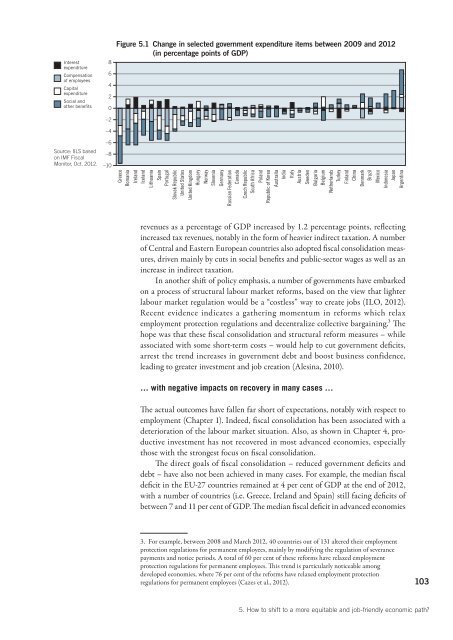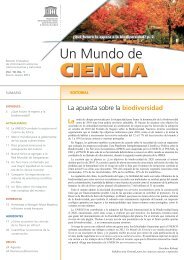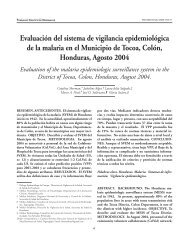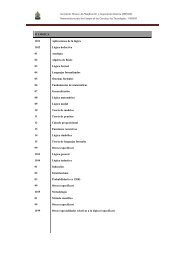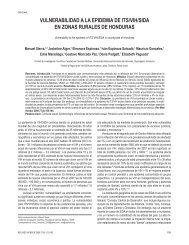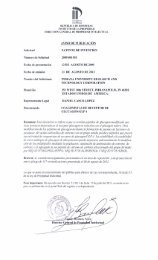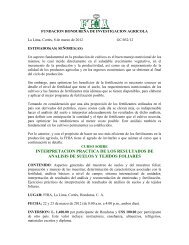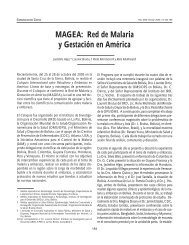World of Work Report 2013 - International Labour Organization
World of Work Report 2013 - International Labour Organization
World of Work Report 2013 - International Labour Organization
You also want an ePaper? Increase the reach of your titles
YUMPU automatically turns print PDFs into web optimized ePapers that Google loves.
Interest<br />
8<br />
expenditure<br />
Compensation 6<br />
<strong>of</strong> employees<br />
4<br />
Capital<br />
expenditure<br />
2<br />
Social and<br />
0<br />
Figure 5.1 Change in selected government expenditure items between 2009 and 2012<br />
(in percentage points <strong>of</strong> GDP)<br />
–2<br />
–4<br />
Source: IILS based<br />
on IMF Fiscal<br />
Monitor, Oct. 2012.<br />
–6<br />
–8<br />
–10<br />
Greece<br />
Romania<br />
Ireland<br />
Iceland<br />
Lithuania<br />
Spain<br />
Portugal<br />
Slovak Republic<br />
United States<br />
United Kingdom<br />
Hungary<br />
Norway<br />
Slovenia<br />
Germany<br />
Russian Federation<br />
Canada<br />
Czech Republic<br />
South Africa<br />
Poland<br />
Republic <strong>of</strong> Korea<br />
Australia<br />
India<br />
Italy<br />
Austria<br />
Sweden<br />
Bulgaria<br />
Belgium<br />
Netherlands<br />
Turkey<br />
Finland<br />
China<br />
Denmark<br />
Brazil<br />
Mexico<br />
Indonesia<br />
Japan<br />
Argentina<br />
revenues as a percentage <strong>of</strong> GDP increased by 1.2 percentage points, refl ecting<br />
increased tax revenues, notably in the form <strong>of</strong> heavier indirect taxation. A number<br />
<strong>of</strong> Central and Eastern European countries also adopted fiscal consolidation measures,<br />
driven mainly by cuts in social benefits and public-sector wages as well as an<br />
increase in indirect taxation.<br />
In another shift <strong>of</strong> policy emphasis, a number <strong>of</strong> governments have embarked<br />
on a process <strong>of</strong> structural labour market reforms, based on the view that lighter<br />
labour market regulation would be a “costless” way to create jobs (ILO, 2012).<br />
Recent evidence indicates a gathering momentum in reforms which relax<br />
employment protection regulations and decentralize collective bargaining.3 The<br />
hope was that these fi scal consolidation and structural reform measures – while<br />
associated with some short-term costs – would help to cut government defi cits,<br />
arrest the trend increases in government debt and boost business confidence,<br />
leading to greater investment and job creation (Alesina, 2010).<br />
… with negative impacts on recovery in many cases …<br />
The actual outcomes have fallen far short <strong>of</strong> expectations, notably with respect to<br />
employment (Chapter 1). Indeed, fi scal consolidation has been associated with a<br />
deterioration <strong>of</strong> the labour market situation. Also, as shown in Chapter 4, productive<br />
investment has not recovered in most advanced economies, especially<br />
those with the strongest focus on fiscal consolidation.<br />
The direct goals <strong>of</strong> fi scal consolidation – reduced government defi cits and<br />
debt – have also not been achieved in many cases. For example, the median fiscal<br />
deficit in the EU-27 countries remained at 4 per cent <strong>of</strong> GDP at the end <strong>of</strong> 2012,<br />
with a number <strong>of</strong> countries (i.e. Greece, Ireland and Spain) still facing deficits <strong>of</strong><br />
between 7 and 11 per cent <strong>of</strong> GDP. The median fiscal deficit in advanced economies<br />
3. For example, between 2008 and March 2012, 40 countries out <strong>of</strong> 131 altered their employment<br />
protection regulations for permanent employees, mainly by modifying the regulation <strong>of</strong> severance<br />
payments and notice periods. A total <strong>of</strong> 60 per cent <strong>of</strong> these reforms have relaxed employment<br />
protection regulations for permanent employees. This trend is particularly noticeable among<br />
developed economies, where 76 per cent <strong>of</strong> the reforms have relaxed employment protection<br />
regulations for permanent employees (Cazes et al., 2012).<br />
103<br />
5. How to shift to a more equitable and job-friendly economic path?


